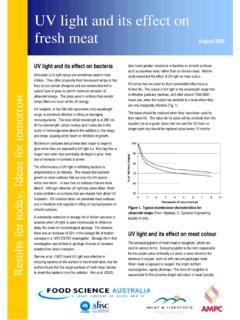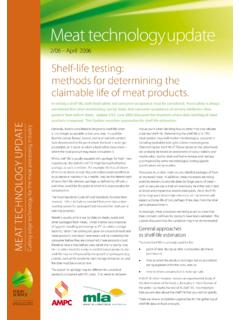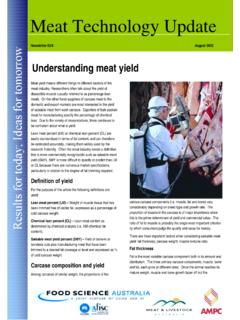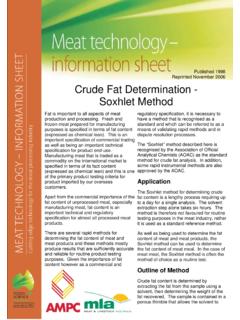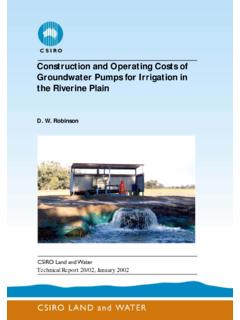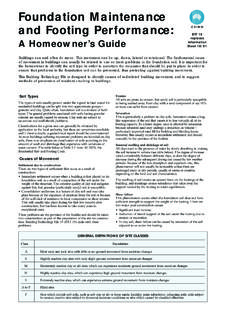Transcription of Modified atmosphere packaging of meat - …
1 Increasingly, red meat for retail display is being prepared and packaged centrally rather than at retail stores. Centralised packaging is growing in popularity because it requires less labour, equipment and space. It also reduces the chances of further cross-contamination. Consumers regard bright red meat as fresh and will often make choices between packs of meat on this basis alone. This affects the marketability because any discoloured meat must be trimmed or sold at discount prices. Therefore, with any distribution system that involves centralised packaging , the appearance must be maintained. Technical basis for MAP The oxygen in air gives fresh meat its bright red appealing colour. Meat blooms whether its surfaces are exposed directly to air or over-wrapped on trays under oxygen-permeable film. The presence of oxygen leads to eventual browning of the meat surface and to growth of spoilage bacteria. Both of these make the meat unacceptable to consumers after several days, even when it is held near 0 C.
2 Vacuum- packaging of beef and lamb in barrier films excludes oxygen from the surface of the meat. This greatly extends the storage life of the meat, particularly when it is stored at 1 to 0 C. However the bright red bloom that is so appealing to retail customers does not occur when oxygen is excluded. Therefore, although the shelf-life extension provides the opportunity for much wider distribution of the meat from a central location, vacuum packs of purple beef or lamb continue to meet with opposition from retail customers. The storage life extension provided by vacuum- packaging is only partly due to the exclusion of oxygen; it is also due to carbon dioxide (CO2) that is generated in the meat tissue. Modified atmosphere packaging of meat Newsletter 01/4 August 2001 Meat Technology Update Figure. 1. Packages of beef mince 3 days after purchase; overwrap above, MAP beneath. Evidence of discolouration near surface of overwrap pack. The knowledge that CO2 inhibits bacterial spoilage of meat and that oxygen is needed to give the bloom that appeals to retail customers, has led to the development of Modified atmosphere packaging (MAP) where relative proportions of gases in the packs are varied to achieve desired outcomes.
3 The principal pigment of fresh meat is myoglobin, which can exist in three main forms. Deoxymyoglobin is the deoxygenated form and is responsible for the purple colour of freshly cut meat or meat stored in the absence of oxygen, such as with vacuum packaged meat. When exposed to oxygen, deoxymyoglobin is rapidly transformed into oxymyoglobin. This form of myoglobin is responsible for the attractive bright red colour of meat typically associated with freshness by consumers (Figure 1). The third form, metmyoglobin, is brown and is irreversibly formed through the oxidation of myoglobin. Consumers relate the presence of this brown colour to the loss of freshness and are reluctant to purchase that particular product. Final meat colour is determined by the relative proportions of the three forms of myoglobin present at the surface of the meat The main gases used in MAP are oxygen, carbon dioxide and nitrogen. Oxygen and carbon dioxide are of most significance in MAP meat and the relative proportions of each of them affect changes in meat colour and microbiological quality.
4 When exposed to O2, fresh meat will exhibit the bright red colour characterised by oxymyoglobin formation. However, low concentrations of O2 around to 1% - lead to rapid onset of irreversible browning. These conditions must be avoided by either keeping the O2 at much higher levels or by excluding it. The role of CO2 is primarily to inhibit the growth and metabolism of microorganisms. CO2 selectively inhibits the growth of gram-negative spoilage bacteria, and, in doing so, may allow other bacteria such as lactic acid bacteria to predominate. The lactic acid bacteria cause spoilage only after extended periods. Nitrogen is used as an inert gas filler. It provides no benefit to the product in terms of bactericidal or bacteriostatic effects but helps maintain the structural integrity of the package when carbon dioxide is absorbed into the meat. The use of nitrogen has no direct effect on meat colour. An important consideration with the use of CO2 in MAP is that it is highly soluble in muscle and fat tissue.
5 It will dissolve into the meat in an approximate 1:1 ratio (1 litre CO2 per kg of meat). The solubility of CO2 is temperature dependent and increases at lower temperatures. Headspace calculations must take the solubility of CO2 into account when planning the packaging parameters. When using a CO2-rich mixture in packs, the ratio of the total package volume (in litres) to the meat weight (in kilograms) is dependent on the gas mix composition and could be up to 3:1 for mixtures in which CO2 predominate. In practice, with packs containing high O2 and moderate CO2, a compromise between that ideal and a tolerable pack size means ratios are usually somewhat lower. A minimum of 20% CO2 throughout the storage period should be aimed for as explained later. The fact that CO2 can be either generated from meat as mentioned earlier, or absorbed into it, means that the concentration of CO2 in packs can vary depending on such factors as its initial concentration in the mixture and the storage temperature.
6 packaging options Three main types of packaging approaches exist for modifying the environment in retail packs of fresh meat: Vacuum / vacuum skin packaging ; high O2 MAP; low O2 MAP. The three approaches differ in their preservative capabilities and their applicability to the centralised packaging of retail meat. The term MAP is usually reserved for procedures where air that surrounds the meat is replaced with gas mixtures that differ in composition from air. Vacuum- packaging is the most common method of modifying the internal environment of a package, however it has not been considered in detail here because it does not fit within this meaning of MAP. Vacuum / vacuum-skin packaging During conventional vacuum packaging , product is placed in a package of low O2 permeability, the air is evacuated and the package is sealed without replacement with another gas mixture. Over time, an environment containing elevated levels of CO2 will develop as the meat product and contaminating microorganisms consume residual O2 and produce CO2.
7 The meat is purple in appearance however and therefore unappealing to many consumers. However, a range of beef, pork and lamb products in heavily printed and decorated bags, that are vacuum packed and put straight on the retail shelf have met with good consumer acceptance. Vacuum-skin barrier packs are an alternative to conventional vacuum packaging for retail portions. A further enhancement of this approach is to use special peelable films. In these systems, air is evacuated and packs are sealed using an O2-permeable film overlain with a peelable O2-impermeable film to maintain the oxygen-free environment of the pack. Prior to retail display, the outer impermeable film is removed and the meat blooms on exposure to air. High O2 MAP The concept of packing fresh red meat under high concentrations of O2 to retard metmyoglobin (browning) formation has been recognised for many decades. High concentrations of O2 are used to increase the amount of oxymyoglobin at and beneath the surface of the meat tissue and a bright red colour.
8 This high O2 concentration does not inhibit the growth of aerobic spoilage organisms. The growth rate of the aerobic spoilage organisms can be reduced by the addition of moderate amounts of CO2 to the gas mixtures. When the CO2 content of a gas mixture exceeds 20%, the rate of growth of the microbial population is approximately halved. Therefore, an atmosphere of around 80% O2 and at least 20% CO2 is beneficial for both microbiological quality and meat colour. In practice atmospheric mixtures of 60-80% O2 and 20-40% CO2 are commonly used. The use of high O2 MAP is suitable for products that are to be held for short periods of time and in which a bright red colour is most desirable throughout the display life. Temperature control is critical to the success of this application. Poor control will lead to growth of spoilage organisms and premature browning of the meat. Low O2 MAP Low O2 MAP is aimed at exploiting fully the inhibitory effects of CO2 on spoilage bacteria and is used on products that are to be transported long distances or stored for several weeks.
9 Products may be gassed with CO2 alone although the water and fat solubility characteristics of CO2 often require the addition of N2 to prevent the pack collapsing. Gas mixtures used in this type of MAP will often contain greater than 65% CO2 with the residual as nitrogen. Despite the obvious drawback of the purple meat colour, it is possible to use this technology in the centralised packaging of retail meat cuts. The retail cuts can be placed in pre-formed plastic trays and after air has been replaced with the gas mixture, a dual-layer film is applied to seal the pack. The dual layer film consists of a peelable O2 impermeable film that when removed after the packs of product have been stored, exposes an O2 permeable film that allows the meat to bloom . This process allows retail meat cuts to be stored for much longer periods of time prior to display than high O2 MAP and thereby lends itself for centralised production systems. However there are reservations about this system because it can take some hours for the meat to bloom sufficiently to put on retail display.
10 Master packaging is a system that also enables centralised packaging of fresh beef cuts. In this technique, several conventional retail packs wrapped in gas-permeable film, are placed in a large high-barrier bag and typically filled with a high CO2 atmosphere . At the retail level, the outer bag is opened and packs removed to allow the meat to bloom. Extended storage and retail display-life have been achieved using this system and it is being used more widely. Meat Types There are considerable differences between the storage life and display life of meat from different species. Beef, lamb and pork have differing susceptibility to chemical and microbial spoilage. packaging systems offer various possibilities depending on the particular conditions that are chosen, but all depend on changing the atmosphere within which the meat is packaged. Beef Consumer preference for the bright-red colour in fresh beef is a major factor in determining the way beef is packaged. As a consequence, the use of vacuum packaging in retail marketing is limited.

